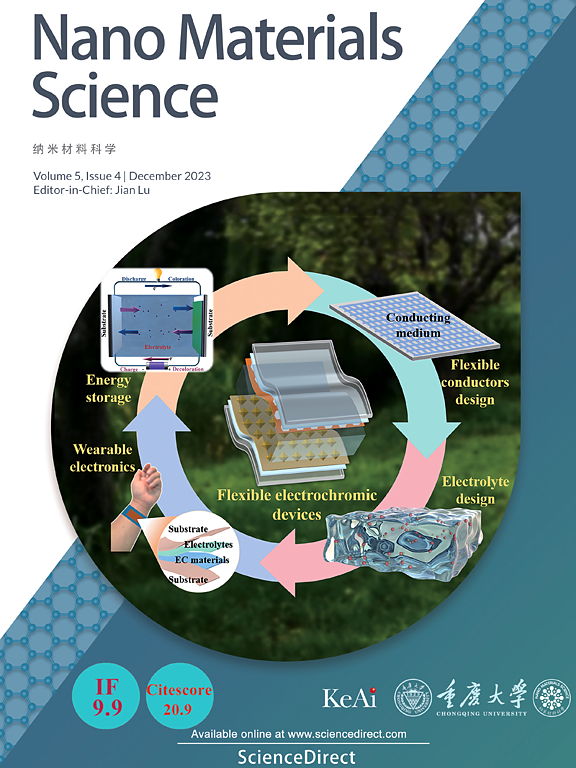用于药物光催化降解和电化学检测的新型三元 Z 方案碳量子点 (CQDs) 装饰 WS2/PANI ((CQDs@WS2/PANI):0D:2D:1D)纳米复合材料
IF 17.9
2区 材料科学
Q1 Engineering
引用次数: 0
摘要
内分泌干扰物(EDCs)和抗生素通过扰乱内分泌系统和传播抗菌素耐药性对人类和动物造成负面影响。目前的需求是利用先进的高效催化系统来清除水体中的药物废物。采用原位聚合辅助绿色合成法制备了新型三元碳量子点修饰的Z-Scheme WS2-PANI纳米复合材料,用于检测雌二醇(EST)和呋喃醌(NFT)。HRTEM显微照片显示,在WS2/PANI(宽度:PANI ~ 20-30 nm)表面形成了平均尺寸为4 nm的CQDs。该三元复合材料具有良好的光催化活性,60 min降解NFT (95.7%), 60 min降解EST(96.6%)。速率动力学研究证实该反应符合准一阶模型。该异质结构通过调制能级构型,增强了对可见光的吸收(2.4 eV),并显著提高了电荷分离度,比原始WS2提高了3倍。这对于增加光诱导电荷的产生和提高催化剂的整体性能是非常有利的。此外,在纸基电极上使用CQDs@WS2/聚苯胺纳米复合材料制备了电化学传感器。CQDs@WS2/PANI的线性响应范围为0.1 ~ 100 nM,检测限为13 nM。这种协同界面相互作用导致修饰电极的电化学性能显著提高。通过电子顺磁共振(EPR)和清道夫实验验证了该方案的正确性。提出了一种中间降解途径。采用FESEM、HRTEM、XRD、FTIR、XPS、uv -可见光谱、PL和TRPL对合成材料进行了表征。因此,本研究提供了一种直接的方法来制造结合二维、一维和零维性质的异质结,从而能够控制能级配置并随后提高光催化和电催化效率。本文章由计算机程序翻译,如有差异,请以英文原文为准。
Novel ternary Z scheme carbon quantum dots (CQDs) decorated WS2/PANI ((CQDs@WS2/PANI):0D:2D:1D) nanocomposite for the photocatalytic degradation and electrochemical detection of pharmaceutical drugs
The endocrine-disrupting chemicals (EDCs) and antibiotics are causing negative effects on human beings and animals by disrupting the endocrine system and spreading antimicrobial resistance. The current need is to eradicate pharmaceutical waste from water bodies using advanced catalytic systems with high efficiency. Novel ternary carbon quantum dots (CQDs) decorated Z-Scheme WS2-PANI nanocomposite was prepared by a green synthesis assisted in-situ polymerization for the photodegradation and detection of Estradiol (EST) and Nitrofurantoin (NFT). HRTEM micrographs revealed the formation of CQDs with a mean size of 4 nm anchored on the surface of WS2/PANI (width:PANI ∼ 20–30 nm). The ternary nanocomposite showed excellent photocatalytic activity, degraded NFT (95.7 % in 60 min), and EST (96.6 % in 60 min). The rate kinetics study confirms the reaction followed pseudo first-order model. This heterostructure exhibited enhanced performances by modulating the energy level configuration, enhancing the absorption of visible light (2.4 eV), and significantly improving the charge separation, three times higher than pristine WS2. These are highly favorable for increasing the generation of photoinduced charges and enhancing the overall performance of the catalyst. Further, the electrochemical sensor was prepared using CQDs@WS2/PANI nanocomposite on a paper-based electrode. The CQDs@WS2/PANI exhibit a linear response of 0.1–100 nM, with a limit of detection of 13 nM. This synergistic interfacial interaction resulted in the significantly improved electrochemical performance of the modified electrode. The proposed Z-scheme was justified by electron paramagnetic resonance (EPR) and scavenger experiment. An intermediate degradation pathway was also proposed. The synthesized materials were characterized using FESEM, HRTEM, XRD, FTIR, XPS, UV-visible spectroscopy, PL, and TRPL. Therefore, this study provides a direct approach to fabricate a heterojunction that combines two-dimensional, one dimensional, and zero-dimensional properties, enabling control over the energy level configuration and subsequent improvements in photocatalytic and electrocatalytic efficiency.
求助全文
通过发布文献求助,成功后即可免费获取论文全文。
去求助
来源期刊

Nano Materials Science
Engineering-Mechanics of Materials
CiteScore
20.90
自引率
3.00%
发文量
294
审稿时长
9 weeks
期刊介绍:
Nano Materials Science (NMS) is an international and interdisciplinary, open access, scholarly journal. NMS publishes peer-reviewed original articles and reviews on nanoscale material science and nanometer devices, with topics encompassing preparation and processing; high-throughput characterization; material performance evaluation and application of material characteristics such as the microstructure and properties of one-dimensional, two-dimensional, and three-dimensional nanostructured and nanofunctional materials; design, preparation, and processing techniques; and performance evaluation technology and nanometer device applications.
 求助内容:
求助内容: 应助结果提醒方式:
应助结果提醒方式:


